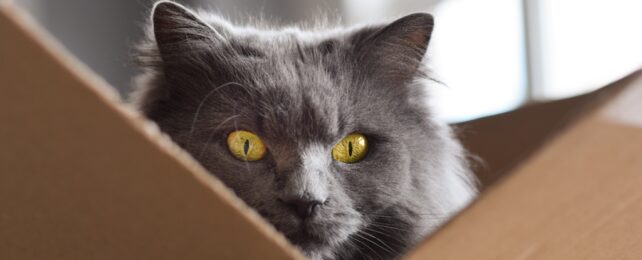A tiny vibrating crystal weighing little more than a grain of sand has become the heaviest object ever to be recorded in a superposition of locations.
Physicists at the Swiss Federal Institute of Technology (ETH) Zurich coupled a mechanical resonator to a type of superconducting circuit commonly used in quantum computing to effectively replicate Erwin Schrödinger's famous thought experiment on an unprecedented scale.
Ironically, Schrödinger would be somewhat skeptical that anything so large – well, anything at all – could exist in a nebulous state of reality.
Superposition states have no equivalent in our everyday experience. Watch a football drop, and you can track its rate of fall with a stopwatch. Its final resting position is as clear as day, and even how it spins in flight is obvious.
Should you close your eyes as it falls, there's no reason to think these states of location or behavior might be any different. Yet in quantum physics, features like position, spin, and momentum don't exist in any meaningful way until you see the ball resting on the ground.
Along with that other heavyweight of theoretical physics, Albert Einstein, Schrödinger wasn't exactly keen on interpretations of experiments that suggested particles lacked precise properties until an observation gave them one.
To show just how absurd the whole idea was, the Nobel-Prize-winning Austrian described a scenario where a particle's unobserved position was linked to the life of an unobserved cat.
Imagine, if you will, a particle randomly spat from a decaying atom, striking a Geiger counter, causing a vial of poison to shatter, instantly killing a cat. Since this all occurs inside a box, the events and their timing remain unobserved.
Going by what's known as the Copenhagen Interpretation of quantum physics, the unseen system exists in a state of all possibilities until its final state is observed. The particle is both emitted and not-emitted. The Geiger counter is activated and not activated. The vial of poison is shattered and not shattered. And the cat is both alive and dead.
This mortal blur is virtually impossible to picture but is easily represented in the wave-like equation of Schrödinger's own devising.
Nearly a century on, Schrödinger's cat is no longer a joke. It's been observed not only in tiny particles but in entire molecules (not to mention in clusters of thousands of atoms). We can manipulate the box to ensure the cat never dies. We can even tinker with the setup to pull the cat apart. In fact, entire technologies are founded on the very principles of objects in states of superposition.
While no actual cats have ever been threatened by a quantum experiment – because, you know, ethics – the theory remains clear. Objects as large as cats, or indeed, humans, elephants, or even dinosaurs, can exist in states of superposition in the same way as electrons, quarks, and photons.
The mathematics leave little room for doubt, yet observing the effects of such a blurred existence on a large scale is a whole other story.
On the atomic level, a smear of unrealized fates can be seen using fairly rudimentary equipment. As the properties of objects grow, the fingerprints of superposition become harder to tease out experimentally.
In this latest experiment, a high-overtone bulk acoustic-wave resonator, or HBAR, served as a 16.2 microgram cat. What it lacked in whiskers and fish breath, it made up for in the fact it could hum across a short range of frequencies when powered by a current.
"By putting the two oscillation states of the crystal in a superposition, we have effectively created a Schrödinger cat weighing 16 micrograms," says senior author and ETH Zurich physicist Yiwen Chu.
For the roles of a radioactive atom, Geiger counter, and poison, the team used a transmon, a superconducting circuit that served as the experiment's power source, sensor, and superposition.
Hooking the two together allowed the researchers to set the HBAR into motion so that its oscillations quivered in two phases at once, a phenomenon that fed back into the transmon.
Just how big future experiments could go is an open question. On a practical front, pushing the limits of scale on superposition could lead to new methods for making quantum technology more robust or form the basis of ever-more sensitive tools for studying matter and the cosmos.
Fundamentally, there are still questions on what it means for matter to be in a superposition at all. Despite decades of advancement in making quantum mechanics more precise, there is still no clarity on why opening the box should make any difference to the fate of Schrödinger's cat.
Just what it means to turn a maybe into an actuality remains as much a mystery in particle physics as when Schrödinger dreamed up his preposterous idea of a cat that should not be.
This research was published in Science.
